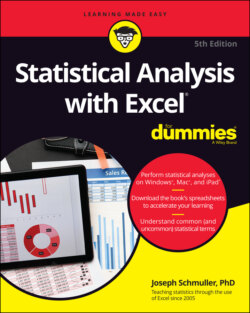Читать книгу Statistical Analysis with Excel For Dummies - Joseph Schmuller - Страница 20
Some Excel Fundamentals
ОглавлениеA chapter on data evaluation might seem an odd place to talk about Excel fundamentals. This section and the next one help you get started with the statistical work that begins in Chapter 2 and continues throughout the book.
Figure 1-2 shows the Excel user interface in Windows 10. The tabbed band across the top is called the Ribbon (as it is on the Mac and the iPad).
FIGURE 1-2: The Excel interface in Windows.
Microsoft has developed shorthand for describing a mouse-click on a command button that lives on a tab on the Ribbon, and I use that shorthand throughout this book. The shorthand is
Tab | Command Button
To indicate clicking on the Insert tab’s Recommended Charts category button, for example, I write
Insert | Recommended Charts
When I click that button (with some data-containing cells selected), the Insert Chart dialog box, shown in Figure 1-3, appears.
FIGURE 1-3: Clicking Insert | Recommended Charts opens this box.
Notice that its Recommended Charts tab is open. Clicking the All Charts tab (which is not in the Mac version) changes the box to what you see in Figure 1-4, a gallery of all possible Excel charts.
FIGURE 1-4: The All Charts tab in the Insert Chart dialog box.
Chart is Excel’s name for graph.
On the iPad it all looks quite a bit different, as Figure 1-5 shows.
FIGURE 1-5: Inserting a chart on the iPad.
Excel on the iPad doesn’t use dialog boxes — instead, the iPad version relies on pop-up menus. So, if you’re an iPad user and I tell you about a procedure that involves dialog boxes, bear in mind that you have to make some adjustments.
To find the bulk of Excel’s statistical functionality, choose (on both Windows and Mac)
Formulas | More Functions | Statistical
This is an extension of the shorthand. It means, “Select the Formulas tab, click the More Functions button, and then select the Statistical Functions choice from the pop-up menu that opens.” Figure 1-6 shows what I mean.
FIGURE 1-6: Accessing the Statistical Functions menu.
In Chapter 2, I show you how to make the Statistical Functions menu more accessible.
On the iPad, it’s a slightly different story. Surprisingly, Excel on the iPad makes statistical functions a bit more accessible than on Windows or the Mac. It’s just
Formulas | Statistical
but you tap the Statistical icon (the word Statistical isn’t onscreen), as Figure 1-7 shows.
FIGURE 1-7: Accessing the Statistical functions on the iPad.
Back in 2010, Microsoft changed the way Excel names its functions. The objective was to make a function’s purpose as obvious as possible from its name. Excel also changed some of the programming behind these functions to make them more accurate.
Excel continues this naming style while maintaining the older statistical functions (pre-2010 vintage, and one — FORECAST — from 2013) for compatibility with older versions of Excel.
You won’t find the older functions on a Mac or Windows Statistical Functions menu. They have their own menu. To find it, choose Formulas | More Functions | Compatibility. On the iPad, tap Formulas | Compatibility. (The Compatibility icon is four icons to the right of the Statistical icon.)
Although I’m assuming you’re not new to Excel, I think it’s wise to take a little time and space to discuss Excel principles that figure prominently in statistical work. Knowing these fundamentals helps you work efficiently with Excel formulas. (If you’re an old hand at Excel, you can safely skip the next few sections.)
